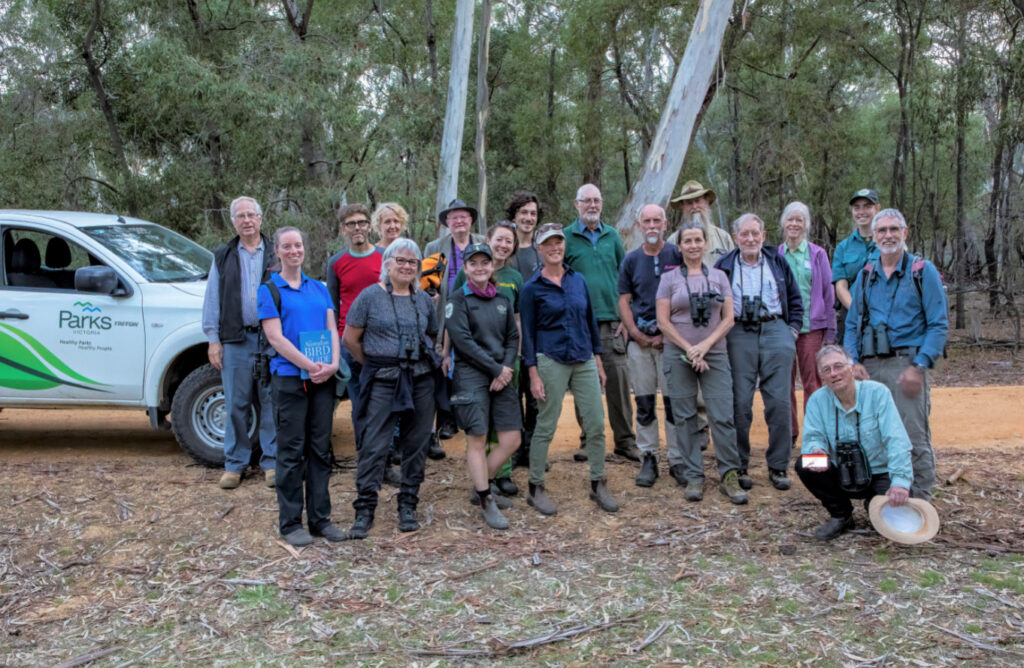Implementing a citizen science bird monitoring project in the Grampians/Gariwerd National Park

Four years after the initial work to establish an ongoing citizen scientist monitoring program in the Grampians / Gariwerd National Park, and train forty bird observers, the eighth biannual Great Gariwerd Bird Survey (GGBS) weekend has just been completed by the volunteer citizen scientists! A wonderful achievement by both the volunteers and Parks Victoria Staff who completed around 1,150 bird surveys in the threatened Heathy Woodland community. Each survey covered 2 hectares and involved 20 minutes of recording birds. This is testament to the skills, generosity and enthusiasm of both the volunteers and ParksVic staff.
This event coincided with the publication of a paper in a peer reviewed journal – Transactions of the Royal Society of South Australia. This paper (available here or read in the PDF viewer below) documented the program design, assessment of its effectiveness and the experiences and thoughts of the participants. The publication of this paper is quite significant and exciting, as I’ll go on to explain below.
The program had been initially reported on as a milestone for the Commonwealth funded Australian Heritage Grant (AHG81062) that underpinned both an extensive monitoring program as well as the establishment of the citizen science project. Such unpublished works form part of what is called grey literature.
One of the great challenges working in the not-for-profit world, where on-ground outcomes are the main priority, is taking our scientific work and transitioning it to a peer reviewed publication in a recognised journal. This is the place where our applied-scientific work is most able to achieve recognition and influence other projects on a wider scale. Grey literature is published informally or non-commercially, or remains unpublished. It can appear in many forms, including government reports, NGO publications, technical or industry reports, theses, statistics, patents, conference papers, blog posts, newsletters and even non-written resources such as posters and infographics. Importantly, grey literature usually has not been peer reviewed by experts in the field prior to being accepted for publication. It may still be good, reliable information and can be invaluable for research, but the lack of peer review and subsequent updates to address any concerns identified, can constrains its ultimate value.
Grey literature is usually not indexed in databases and is only available to a limited few or stored on a few obscure web sites. Consequently it is often difficult to locate and after a few years will sometimes ‘disappear’, such as for example when a web site is upgraded. Publication in a recognised journal with international distribution and referencing overcomes these constraints.
The challenge lies in finding the time, resources and (after a long busy week on other priority tasks) the motivation, to convert the document into a publishable ‘paper’, all usually completed outside of formally funded programs.
The above paper is one of the two produced to report on the results of this project. The second paper (available here or read in the PDF viewer below) reported on a series of surveys at the same sites now monitored by the citizen scientists. This paper used the monitoring of bird species richness (number of different species) and abundance (number of individuals) within the GGNP Heathy Woodland Ecological Vegetation Class (EVC) to assess seasonal changes in bird community and foraging guild composition. The information was compared with surveys done at the same sites for an Honours project 13 years previously and with research by Possingham and Possingham in the same habitat in the Mount Lofty Ranges.
This project required funding from a number of additional sources pulled together from various grants (including the Australian Heritage Grant, Victorian Government’s Weeds and Pests on Public Land program), funded surveys for Parks Victoria, and in-kind support and funding provided by Nature Glenelg Trust. The opportunity to continue surveys using the same method undertaken by the same practitioner, at the same sites over two years and across six seasons is rare in the world we operate in. As such, it represented an important data set and well worth sharing.
So congratulations to the citizen science team, and all involved, we’ve now got a fantastic ongoing project underway, producing scientifically invaluable – now published – data!
